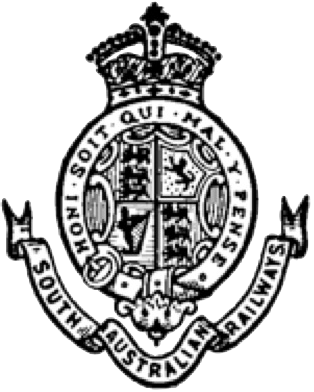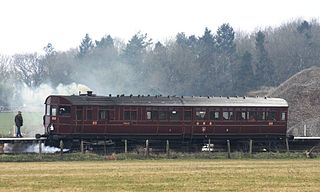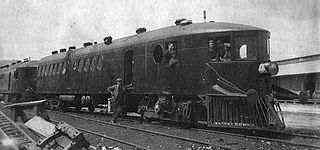Related Research Articles

A railcar is a self-propelled railway vehicle designed to transport passengers. The term "railcar" is usually used in reference to a train consisting of a single coach, with a driver's cab at one or both ends. Some railway companies, such as the Great Western, termed such vehicles "railmotors".

Summerland Way is a 199–kilometre state route, designated B91, in New South Wales. It runs generally north from Grafton to the state border with Queensland just west of Mount Lindesay, and continues from there into Queensland as Mount Lindesay Highway. It was named as the region in runs through is a popular tourist area for people during summer.

South Australian Railways (SAR) was the statutory corporation through which the Government of South Australia built and operated railways in South Australia from 1854 until March 1978, when its non-urban railways were incorporated into Australian National, and its Adelaide urban lines were transferred to the State Transport Authority.

The 620/720 class railcars were a class of diesel multiple unit built by the New South Wales Government Railways and operated from 1961 until 2007.

The South Coast railway line was a railway from Brisbane, the capital city of Queensland, Australia. The route via the South Coast to Tweed Heads on the border of Queensland and New South Wales. The line operated from 1889 to 1964. The Gold Coast railway line re-opened in 1996 along a modified alignment in the north and a new route south but does not extend as far south yet as the South Coast line.
Railmotor is a term used in the United Kingdom and elsewhere for a railway lightweight railcar, usually consisting of a railway carriage with a steam traction unit, or a diesel or petrol engine, integrated into it.
The railways of New South Wales, Australia, use a large variety of passenger and freight rolling stock. The first railway in Sydney was opened in 1855 between Sydney and Granville, now a suburb of Sydney but then a major agricultural centre. The railway formed the basis of the New South Wales Government Railways. Passenger and freight services were operated from the beginning. By 1880, there was a half hourly service to Homebush.

The steam rail motors (SRM) were self-propelled carriages operated by the Great Western Railway in England and Wales from 1903 to 1935. They incorporated a steam locomotive within the body of the carriage.

The Gulflander is a passenger train operated by Queensland Rail on the isolated Normanton to Croydon line in the Gulf Country of northern Queensland, Australia.

The McKeen Railmotor was a 6-cylinder self-propelled railcar or railmotor. When McKeen Company of Omaha, Nebraska, U.S.A., first unveiled the car in 1905, the McKeen was among the first engines with a distillate-fueled motor. Revisions to the McKeen car led to the modern self-propelled gasoline rail-motor vehicle, and the "contours of the porthole windows, the front-mounted gasoline engines, and other features anticipated the streamline concept."
The Kerr Stuart steam railmotor, also known as Motor Car 3, was a steam railcar operated by the Victorian Railways from 1913 to 1924.

The Diesel Electric Rail Motor (DERM) was a type of railmotor operated by the Victorian Railways in Australia.

The DRC was a class of railmotor operated by the Victorian Railways on its country rail network in Victoria, Australia. The cars were built by Tulloch Limited in New South Wales, and featured aluminium and steel construction, air-conditioning, and twin diesel engines with hydraulic transmissions.

The CPHrail motors were introduced by the New South Wales Government Railways in 1923 to provide feeder service on country branch lines.
This article lists some of the terminology used at present and in the past by railway employees, railway enthusiasts and railway historians in Australia. Many appear from time to time in specialist, rail-related publications. Significant regional variations exist, indicated by abbreviations of the state or railway.

The Eugowra railway line is a closed railway line in New South Wales, Australia. The 80 km (50 mi) branch line joins the Blayney–Demondrille line at Cowra.

Tulloch Limited was an Australian engineering and railway rolling stock manufacturer, located at Rhodes, New South Wales.

The 600/700 class railcars were a class of diesel multiple unit built by the New South Wales Government Railways. They were built to operate on branch lines from 1949 with low traffic volumes later being transferred to Newcastle and Wollongong to operate suburban services until withdrawn in 1994. However, one 600 class railcar was converted to solar operation for use on the Byron Bay Train service. The upgraded train entered service on 16 December 2017 and is believed to be the world's first solar-powered train.

A steam railcar is a rail vehicle that does not require a locomotive as it contains its own steam engine. The first steam railcar was an experimental unit designed and built in 1847 by James Samuel and William Bridges Adams. In 1848, they made the Fairfield steam carriage that they sold to the Bristol and Exeter Railway, who used it for two years on a branch line.

Greyhound racing in Australia is a sport and gambling activity. Australia is one of several countries with a greyhound racing industry. The industry laws are governed by the State Government but the keeping of greyhounds is governed by the Local Authority.
References
- ↑ "The War. Hospital Ships". The Morning Bulletin . Queensland, Australia. 8 April 1916. p. 9. Retrieved 8 April 2024– via National Library of Australia.
- ↑ W. S. Ramson (1988). The Australian National Dictionary. p. 675. ISBN 0195547365.
- ↑ "Tin Hare Coursing". The Age . No. 22, 591. Victoria, Australia. 1 September 1927. p. 10. Retrieved 8 April 2024– via National Library of Australia.
- ↑ "Tin Hare Racing". The Sydney Morning Herald . No. 27, 999. New South Wales, Australia. 30 September 1927. p. 9. Retrieved 8 April 2024– via National Library of Australia.
- ↑ "Tin Hare Racing". The Bunyip . No. 4, 108. South Australia. 4 November 1927. p. 6. Retrieved 8 April 2024– via National Library of Australia.
- ↑ "Tin Hare Boom". Crookwell Gazette . Vol. XLIII, no. 37. New South Wales, Australia. 13 July 1927. p. 4. Retrieved 8 April 2024– via National Library of Australia.